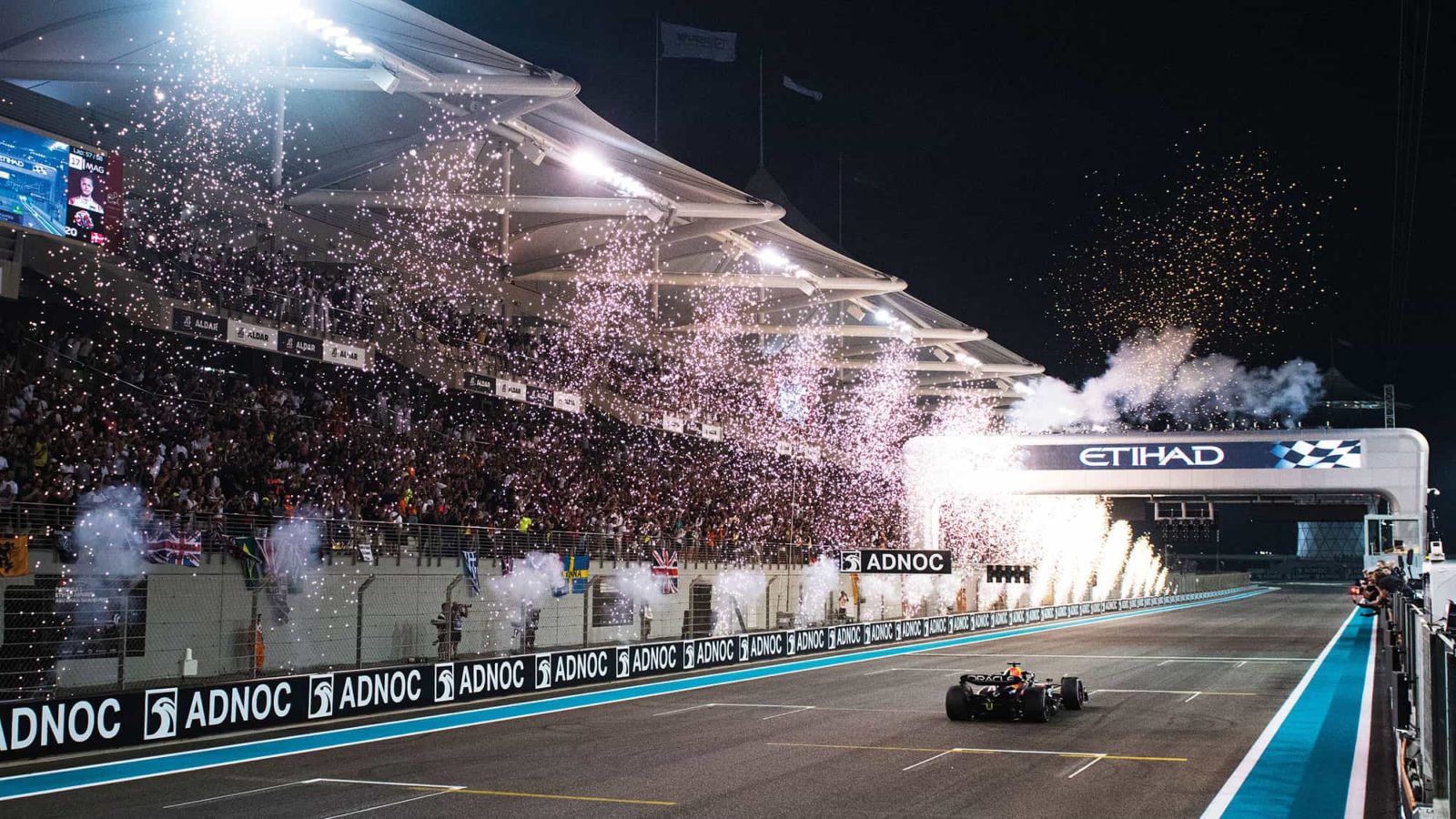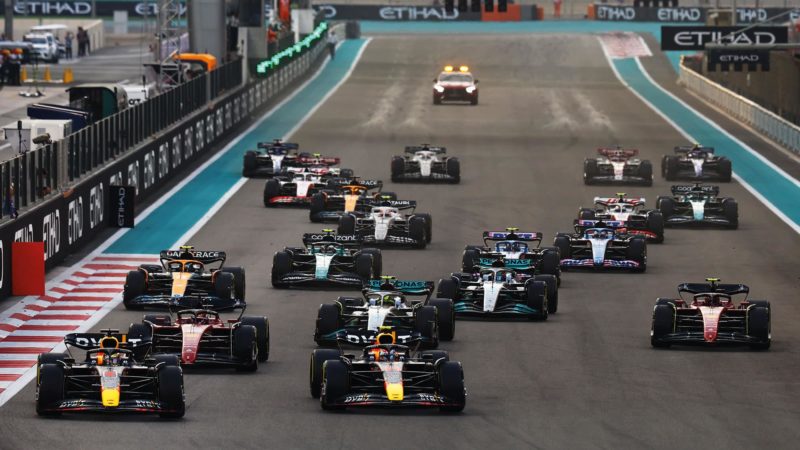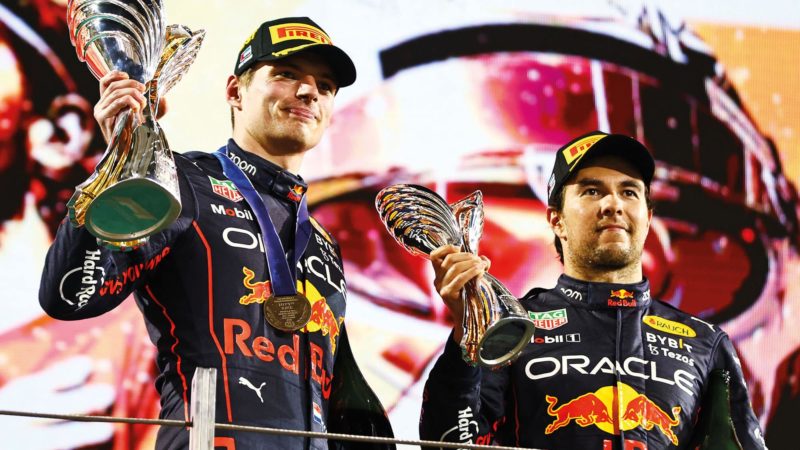Red Bull team-mate troubles brew as Verstappen wins Abu Dhabi GP
Abu Dhabi lacked the drama of 2021, but as Mark Hughes reveals, driver theatrics are starting to get awkward for Red Bull

Max Verstappen’s win in Abu Dhabi stretched his record for most wins in a season to 15
Getty Images
The only thing of significance left to settle as the Formula 1 circus descended on Abu Dhabi for the final race was who would be championship runner-up to the dominant Max Verstappen: his team-mate Sergio Pérez or Max’s early season rival Charles Leclerc.
Verstappen, who’d already established a record number of wins in a season, extended that to 15 around the Yas Marina circuit: a dominant but controlled drive from pole, his one-stopping strategy imposing a very careful monitoring of his tyres. This allowed Charles Leclerc’s Ferrari never to be too far away. The conservative approach made Verstappen’s win more secure, but had a complicating effect on Pérez’s attempts at beating Leclerc.
Pérez and Leclerc arrived in Abu Dhabi equal on points so whichever of them finished ahead in this race would be the runner-up. It mattered to Leclerc as some sort of consolation to how his early season searing pace had not translated into a title challenge. It probably mattered to Pérez and if he could succeed in clinching the position it would be the first time in Red Bull’s history it had secured a 1-2 in the drivers’ championship.
The backdrop to that question was the niggle between Verstappen and Pérez which had been laid bare a week earlier in Brazil, when Verstappen, with the title already secured, had refused to hand Pérez back sixth place in the latter’s bid for more points. This dated back to Monaco and Verstappen’s belief that Pérez’s red flag-causing accident in the final Q3 runs – which had denied Verstappen the lap which was about to put him ahead of Pérez on the grid – was deliberate.
Although Verstappen insisted post-race in Brazil that everything had been resolved in a team meeting and that he would be open to helping Pérez in Abu Dhabi, no-one believed that help would ever extend as far as surrendering a race victory.
Verstappen did however agree to give his team-mate a tow in Q3 and it probably made the crucial difference in putting Pérez on the front row – for third-fastest Leclerc was only a few thousandths slower. Carlos Sainz was alongside Leclerc on the second row, with an all-Mercedes third row, Lewis Hamilton from George Russell, the silver cars’ high drag punished on this track much more than at the preceding three where it had been competitive.
As Verstappen and Pérez ran 1-2 in the early stages, all looked under Red Bull’s control. In the latter part of the season the Ferrari has tended to be harder on its tyres and it was not expected that Leclerc in third would be able to hold onto a sustained Red Bull pace. But that was to reckon without how gently Verstappen was running his race, determined to make his chosen one-stop strategy work. At that pace, Leclerc’s tyres were holding on fine – and it was actually Pérez who ran into tyre trouble.

Red Bulls lead into Turn 1 with the runner-up position in the championship still up for grabs
Getty Images
In getting himself out of Leclerc’s DRS range in the opening laps, with the tyres at their most vulnerable, Pérez had induced graining of his outside front. As this developed so he fell away from even Verstappen’s relatively gentle pace and came under increasing threat from Leclerc. To prevent the Ferrari from potentially undercutting past him, Red Bull brought Pérez in on lap 15, which was very early even for a two-stop strategy. This enforced stop would come to have a cascading set of penalties.
The balance between how hard it was feasible to push the tyres and the pitstop time loss made this race delicately pivoted between one-stop and two. Even post-hoc analysis revealed no clear ‘better’ strategy. The total race time was calculated as almost identical. Using a two-stop you could push harder by around 0.4sec per lap to make up the 21sec loss of an extra stop – which was about as much as the tyres could take. Had the tyres allowed you to push 0.5sec or 0.6sec harder, then the two-stop would have been superior, had they only allowed you to push 0.3sec harder, the one-stop would have been clear favourite. The margins were so fine there was no way of knowing going in.
The softest of the three compounds was useless as a race tyre with degradation rates too high to give the required stint lengths. So a combination of medium and hard was going to be required, regardless of one-stop or two. Verstappen had tried one of his two sets of hards in practice and with only one fresh set remaining was essentially committed to a one-stop. Pérez and Leclerc went into the race still with their original two sets of hards and so had the flexibility of one or two-stopping.
So as Pérez came in, to avoid a possibly two-stopping Leclerc from undercutting, it was great news for Ferrari on the pitwall. They had monitored Leclerc’s tyre state and he kept responding with “good”. Verstappen’s conservative one-stopping pace at the front was allowing Leclerc to keep his tyres in good shape and still be only around 8sec behind. It meant potentially Ferrari could put him on a one-stop, with Pérez forced by that early graining to two-stop.
Running six laps longer on his original mediums than Pérez, Leclerc switched to one of his fresh sets of hards with the intention of running them to the end. This brought Pérez back up to second and only a few seconds behind Verstappen, once the latter had made his single stop. This was where things became potentially awkward for Red Bull. To allow him a chance of pulling out enough time over Leclerc to buy the second stop, Pérez really needed to be going faster than Verstappen was currently running. “I’m being held up by Max,” he radioed, albeit from around 3sec back. Verstappen was asked if he could up the pace for a lap or two, to give Pérez more space. Verstappen complied, but not without some complaint. This was compromising the smooth-running of his race.
“Ferrari had taken full advantage of Red Bull’s awkward dynamic”
Ideally, the team may have asked Verstappen to allow Pérez – on a different strategy – past to maximise Checo’s chances of beating the Ferrari driver (in both the race and championship). The hazard of that was, because the race was so delicately poised between one-stop and two, it may have resulted in Pérez ‘accidentally’ also beating Verstappen! After Brazil, that was probably not a scenario anyone at the team relished.
Instead, discussions were initiated with Pérez about not making the second stop, about staying out there and fending off the fresher-tyred Leclerc. Pérez, concerned about how quickly his first set of tyres had degraded, didn’t like the idea of that. With the team unwilling to ask Verstappen to move aside and Pérez unwilling to try staying out, the only alternative was to make the second stop, come out behind Leclerc and try to catch him before the end, using his fresher tyres. There were questions afterwards about why Pérez had not closed up nearer to Verstappen, but it was because that was the very moment the team was considering converting him to a one-stop and to have pushed on would have been potentially disastrous. Instead, his hand was forced on lap 33 as Leclerc again edged within undercut range. In Pérez came, out Leclerc remained. With 24 laps to go, the Red Bull exited the pitlane 20sec behind the Ferrari and on tyres which were 12 laps newer.

Smiles on the podium – but the relationship between Max and Checo is far from warm
Getty Images
Just as he had been delayed on his out-lap first time around by not having cleared the dicing Sebastian Vettel and Fernando Alonso, so this time he had to find his way around the one-stopping Mercedes of Hamilton, which delayed him further by re-passing and staying ahead for a further lap. Here were those cascading penalties of that early grained tyre and the early stop it imposed.
This fight had taken enough from his tyres that by the time he was close to Leclerc, he had no significant pace advantage. Leclerc second, Pérez third in both the race and the final points table. Strategically Ferrari had called this one perfectly, taking full advantage of the awkward dynamic in the Red Bull camp.
Sainz – who had deliberately not interfered with Leclerc’s race – was fourth, pushed into two-stopping by an early dice with Hamilton. The latter’s Mercedes retired from the fray with hydraulics failure. George Russell in the sister car took fifth. Lando Norris, running a lonely race in his McLaren, was sixth and made a second stop sufficiently late in the race (and helped by the tyre conserving going on up front) to set the fastest lap. Two-stoppers Esteban Ocon and Lance Stroll finished ahead of the one-stopping nose-to-tail Daniel Ricciardo and Sebastian Vettel. Alonso’s final dice with the retiring Vettel after 14 years was brought to an end by yet another water leak in the Alpine.
